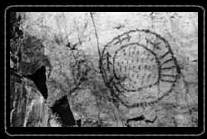Let's take a trip to Siberia! No we don't need a boat, or even a plane, we can walk there! During the Ice Age, one could travel between North America and Asia on foot. This was possible because of the shelf of land that was exposed when most of the world’s water became glaciated and heaped up on other areas of land. This area is called the "Bering Land Bridge." In fact, some believe that this is how the first humans migrated to North America. As the bridge developed tundra vegetation, large animals, termed Megafauna, grazed on the plants and crossed into North America. In the never-ending search for food, their predators followed them. Among the predators from Asia were humans (Bunyan).
The rock painting at the bottom of the page, was photographed near Pinche on Stuart Lake. It tells the story of how the Native people came to this area: "Long ago many tribes travelled together. One by one, over five winters, as they came upon good water, good salmon fishing, and hunting, They said, 'This is where we are going to stay.' It was agreed everyone would gather one time of year at a central place on the Tsi Chakoh to share news of the previous year and to plan for the year to come."
The word Megafauna means ‘large animals’ and is the term given to animals of this time period. Grazing on the North American landscape we would see giant bears, armadillos and even giant beavers that weighed up to 800 pounds! There were also other strange animals that have long been extinct, such as condors with a 16-foot wing span, long-legged antelope-like pigs, and woolly mammoths.
Most of these animals were extinct by the end of the Pleistocene Epoch. Perhaps the introduction of foreign and efficient predators, humans, resulted in over-hunting of all species or even just one keystone species whose absence would cause an unfavourable change of habitat. Another theory is that global warming melted the ice locked in glaciers and changed vegetation patterns, making it impossible for some species to survive.
Back in the present day, only about fifteen species of Megafauna remain, including the caribou.
